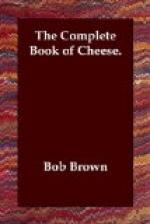The school that plumps for malty Rabbits and the other that goes for milky ones are equally emphatic in their choice. So let us consider the compromise of our old friend Frederick Philip Stieff, the Baltimore homme de bouche, as he set it forth for us years ago in 10,000 Snacks: “The idea of cooking a Rabbit with beer is an exploded and dangerous theory. Tap your keg or open your case of ale or beer and serve with, not in your Rabbit.”
The Stieff Recipe BASIC MILK RABBIT (completely surrounded by a lake of malt beverages)
2 cups grated sharp cheese 3 heaping tablespoons butter 1-1/2 cups milk 4 eggs 1 heaping tablespoon mustard 2 teaspoons Worcestershire sauce Pepper, salt and paprika to taste—then add more of each.
Grease well with butter
the interior of your double boiler so
that no hard particles
of cheese will form in the mixture later
and contribute undesirable
lumps.
Put cheese, well-grated,
into the double boiler and add butter
and milk. From
this point vigorous stirring should be indulged in
until Rabbit is ready
for serving.
Prepare a mixture of Worcestershire sauce, mustard, pepper, salt and paprika. These should be beaten until light and then slowly poured into the double boiler. Nothing now remains to be done except to stir and cook down to proper consistency over a fairly slow flame. The finale has not arrived until you can drip the rabbit from the spoon and spell the word finis on the surface. Pour over two pieces of toast per plate and send anyone home who does not attack it at once.
This is sufficient for six gourmets or four gourmands.
Nota bene: A Welsh Rabbit, to be a success, should never be of the consistency whereby it may be used to tie up bundles, nor yet should it bounce if inadvertently dropped on the kitchen floor.
Lady Llanover’s Toasted Welsh Rabbit
Cut a slice of the real Welsh cheese made of sheep’s and cow’s milk; toast it at the fire on both sides, but not so much as to drop (melt). Toast on one side a piece of bread less than 1/4 inch thick, to be quite crisp, and spread it very thinly with fresh, cold butter on the toasted side. (It must not be saturated.) Lay the toasted cheese upon the untoasted bread side and serve immediately on a very hot plate. The butter on the toast can, of course, be omitted. (It is more frequently eaten without butter.)
From this original toasting of the cheese many Englishmen still call Welsh Rabbit “Toasted Cheese,” but Lady Llanover goes on to point out that the Toasted Rabbit of her Wales and the Melted or Stewed Buck Rabbit of England (which has become our American standard) are as different in the making as the regional cheeses used in them, and she says that while doctors prescribed the toasted Welsh as salubrious for invalids, the stewed cheese of Olde England was “only adapted to strong digestions.”




